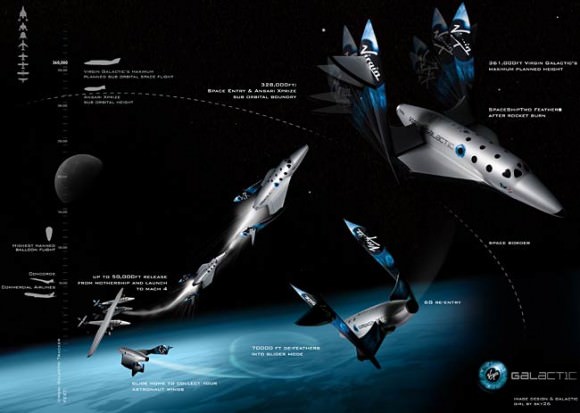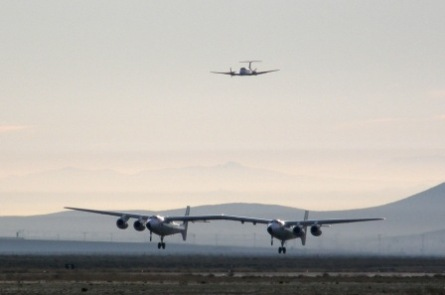Virgin Galactic’s WhiteKnightTwo (WK2) made its first test flight on Sunday, Dec. 21, a 59min shakedown flight of the twin fuselage aircraft at the Mojave Air and Space Port in California. WK2 climbed to a maximum altitude of 16,000ft (4,880m). “It reached an altitude 4,000ft above the original test plan’s maximum altitude,” said Virgin Galactic president Will Whitehorn. “That is how confident we are about the aircraft. Now we have to download all the data. There will be another flight early in the new year.” WK2 will carry Virgin’s SpaceShipTwo, the space plane that will bring passengers on suborbital flights, hopefully by 2011. FlightGlobal.com obtained exclusive video of the test flight, which can be viewed here.
The hour-long test flight of the four-engine WhiteKnightTwo used a skeleton flight crew. Previously last week, WK2 was taken out for four runs down the runway and a brief lifting of the nose gear on Dec. 20, and low-speed trips down the runway on Dec. 16 and 12.
Both WK2 and SS2 are being built by Scaled Composites of Mojave, CA, and Virgin Galactic has five SS2 rocket planes and two of the carrier crafts on order, with options on more. The WK2/SS2 combination will serve as the backbone for Sir Richard Branson’s suborbital spaceline company. The price per seat on the two pilot/six passenger suborbital SS2 is $200,000.

Virgin Galactic hopes to start operating commercially by 2011 from the New Mexico Spaceport America. The new spaceport, soon to be under construction, announced that it had received its license from the FAA for horizontal and vertical space vehicle launches on 15 December and it expects to be fully operational in 2010.
Source: FlightGlobal.com


Cool – I’ve been waiting for an update to the Spaceship Two story. Can’t wait ’till they start commercial flights. Too bad I can’t afford it, but the price will come down eventually.
Best of luck to them, I say.
Would it not be more normal to say “Scaled Composits White Knight Two (WK2)”. Just like you say “Boeing’s 747” not “Virgin Air’s 747”.
On is the manufacturer and the other is a purchaser.
Sweet! Looks like I need to design a few more websites and save up some dosh 🙂
Not sure the line between manufacturer and purchaser are so clear cut on this one. Virgin Galactic has obviously had allot of input on Burt Rutans designs.
Its obvious that the suborbital hop they are performing is not the sum total of the service they intend to provide. Plus its damn good advertising to claim yourself as the first space airline.
That said, its a good thing overall.
What needs to be demonstrated is not that commercial spaceflight is necessarily cheap, but that you can run it profitably and reliably.
Once there is a proven market for space tourism its easier to get investments on more advanced spacecraft.
“Would it not be more normal to say “Scaled Composits White Knight Two (WK2)”. Just like you say “Boeing’s 747” not “Virgin Air’s 747″.
On is the manufacturer and the other is a purchaser.”
I agree. Where space launch is involved, it’s been historically true that the launcher manufacturer is also the launch provider. Now we’re starting to move toward the aeronautical model (indeed, Boeing was forced to divest itself of United air lines, which it initially owned in early aviation, and sell aircraft without favor to all customers) of manufacturer and operator
It’s conceivable (epically if Virgin is outstandingly successful) that other operators may want to acquire SS2/WK2s themselves…
$200,000 – Why is it so fecking expensive? Besides amortization, I don’t understand how this enormous price is justified. Airline companies offer us bargain rates for intercontinental flights below $400 which nevertheless require a cruising level of 10 kilometers. Why then $200,000 for six times that level?
Because your typical airlines use aircraft and parts that are manufactured in bulk. Quantity of scale brings the price down. I work on custom fitted surveillance aircraft and as an example, an intel core 2 duo computer custom built for our aircraft comes in at US$50K. Not to mention the US$2M surveillance radar! So in my opinion $200K a seat is pretty damn cheap! Personally I can no way afford it now, but I’ll definitely be able to afford it by 2011 (don’t know how yet but I’ll make it happen).
And everyone at our airport refers to aircraft by the operator rather than the manufacturer. Heck anyone with any aircraft knowledge knows that a 747 is a made by Boeing for example, why state rhetorical information?
The price per ticket will most likely come down.
When I was a kid, flying from Europe to the US and back cost at least 12 weekly wages – ocean liner was thew cheaper option, but took a lot longer.
Now, and for the last ten years: no more than one weekly wage – ocean liner is a luxury.
🙂
How many people on an aircraft split the cost of the aircraft, crew, fuel, maint, R&D, etc?
Only 4 will split the cost of the first space tourist craft.
Also, I believe the life of aircraft and number of sorties will far exceed that of the spacecraft.
The biggest reason of all…. supply vs. demand. As long as someone pays what they want and the craft fills up… the price will be what it is.
Aodhhan! You said: “How many people on an aircraft split the cost of the aircraft, crew, fuel, maint, R&D, etc?”
That would mean that if an enterpreneur can scatter the costs of a suborbital spaceflight over all other of his cost-effective undertakings that they would play no role on its balance any longer? So virgingalactic is just not big enough? So somebody (like Deutsche Lufthansa AG) should take overtake Virgin Galaxy, thus the costs of a suborbital spaceflight can be reduced?
What would it take for another agency to fullty takeover what NASA does. I mean entirely!
I’m sorry but it seems that the smallest jobs cost so much when NASA is involved.